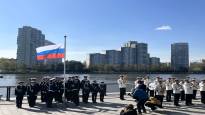MOSCOW The summer operating season of the Moskva River opened with a typical celebration. In front of the southern river station, a military band played the national anthem while the Russian flag was raised.
Moscow is Russia’s showcase, not the mayor by Sergei Sobyanin the administration has spared no expense in polishing this showcase.
It is also important for the Russian authorities to keep the capital’s middle class satisfied and calm.
A retired couple Valery and Nelya Chistyakov had arrived to watch the opening ceremony and go on a river cruise. They had already recently visited one of the new river routes operated by electric ships.
– It opened up a lot of new things for us. You can see construction sites from the river, which you can’t see from the beach, Valery Chistjakov praised.
Deputy Director of the Transport Agency of the City of Moscow Roman Latypov was happy that in addition to tourist and pleasure traffic, regular passenger traffic on the river is also developing. Last year, around 650,000 people traveled on two routes.
– The routes worked all winter and showed that this is indeed a regular mode of transport that works all year round, Latypov said.
Regular passenger traffic on the river was interrupted in the 90s.
– We see that already a large number of people use these ships every day to travel to work. We are happy that the Moskva river will become a traffic channel again.
Valery Chistyakov from Moscow thought, however, that the new river routes will serve even more recreational traffic. For a pensioner, the ship tickets still seemed expensive.
The subway is expanding
The new electric ships are only a small part of the big city’s public transport network. Sobyanin’s administration is expanding and renewing the capital’s public transport.
Last year, the metro’s new, large ring line was completed, one of the largest construction projects in Russia in recent decades. The tunnel was dug over a length of 70 kilometers.
The mayor has promised that 30 more metro stations will be built in the next few years and that 90 percent of Muscovites will live near metro stations before long.
The metro, which started operating in 1935, is the pride of Moscow.
It’s no wonder that the subway was also introduced to a US conservative media personality To Tucker Carlsonwhen he visited Moscow in February to interview the president Vladimir Putin.
Wealth in Russia is concentrated in Moscow
Moscow can still invest in its image, because the Russian economy is growing fueled by war spending and wealth in Russia is disproportionately accumulating in the capital.
It often arouses resentment in other regions, which experience Moscow sucking the riches of the country into their own coffers.
Most large companies have their headquarters in Moscow. They don’t earn their profits only in Moscow, but pay taxes on their profits there.
Wages in the capital are the highest in Russia, so the capital also receives more income from them than other regions. Moscow also collects income taxes from residents of nearby cities who work in the capital.
At the same time, relatively more men from Russia’s poor regions than from the capital have been mobilized and recruited for Russia’s war of aggression in Ukraine.
Labor shortage can be a stumbling block
Large-scale projects like the metro expansion would not be possible if the Russian economy had so far survived better than expected from Western sanctions.
The International Monetary Fund (IMF) predicts that the Russian economy will grow by 3.2 percent this year. In the background of the growth figures, military industrial production is booming, which is not healthy for the economy in the long term.
The acceleration of inflation can threaten the Russian economy, especially when the country also has record low unemployment.
The labor shortage is already slowing down economic growth, and the situation is not getting any easier, as men are still needed at the front. Many young Russian men also fled the country after the partial launch of the movement in autumn 2022.
The labor shortage is not alleviated by the fact that, after the Crocus City Hall terrorist attack in March, the attitudes of citizens and authorities towards Central Asian migrant workers have hardened.
The ruble’s weakened exchange rate also reduces the attractiveness of the Russian labor market. Migrant workers most often convert the money they earn from rubles to dollars, and the unfavorable exchange rate eats into their income.
